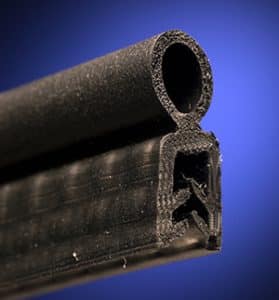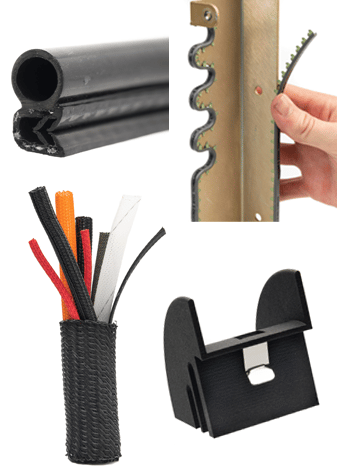These two related materials have different properties that lend themselves to specific applications.
However they are both useful and versatile materials. The comparison below will help you understand the properties -and uses of each product.
In DTi’s 37+ years of experience, we have found that components fail because of errors at either the design stage and/or during installation. So care has to be taken in not only choosing the correct material for the job but also in ensuring those materials are installed correctly. Failure at either step will make or break the success of the component in operational usage.

EPDM
EPDM “Ethylene Propylene Diene Monomer” is a synthetic rubber elastomer. It’s stable, saturated polymer backbone gives it the toughness that makes it widely used in construction for seals and roofing and in the auto industry for window seals, door seals, and gaskets for electrical applications.
Key attributes
- Abrasion and tear resistance
- Stands up well to up to harsh weather conditions – rain, sleet, snow, ozone and UV.
- Its weak point is temperature resistance as it will deform at higher temperatures.
- EPDM has a shorter life span than silicone, so will need to be replaced more frequently.
Silicone Rubber
Silicone rubber (SIR), -Polydimethylsiloxane- is an inorganic polymer based on quartz sand. It is composed of silicon, carbon, hydrogen, and oxygen. It is used extensively in industries from rail, aerospace, food service, automotive, electronics, medical devices and implants, and even toys.
Key attributes
- Outstanding resistance to ozone and weathering although EPDM is better for UV & water resistance
- Resistant to high temperatures – does not deform or lose its properties compared to EPDM.
- It can be sterile and food safe so is widely used in the medical/food service industry for tubing, seals & gaskets.
- Temperature resistance, sterility & longer life cycle means it is mostly seen as superior to EPDM although it is more costly.
Let’s look at DTi’s product attributes in more detail.
Temperature
Temperature resistance is critical in applications that subject components to wide temperature ranges. Think ovens. At high temperatures you do not want your rubber seal to melt, deform or become brittle with cold, either extreme could cause it to fail during operation with potentially disastrous results for the equipment and its output.
EPDM should be used if your application between -40°C to 121°C (250°F).
Silicone should be used if your application between -40°C to 200°C (392°F) some formulations can go to 270°C (518°F).
Caveat emptor: we present DTi product specs here however there is variability in temperature ratings by formulation and supplier so carefully check product specs against your application needs.
Elongation/Tear Resistance
Different applications will require hardness/stiffness while others will require the product to flex and stretch to accommodate changing conditions. You’ll want to consider how much a seal or gasket should be able to indent and change shape under operational conditions in order to avoid failure.
Silicone stretches more than EPDM and can elongate up to 800% and has a high tear resistance.
As a result it is used as vacuum membranes and presses that help form and bond composites under extreme pressure.
Temperature resistance also plays a part here. DTi silicone & EPDM will stay flexible to -40°C -before becoming brittle.
Oil resistance
Both materials tend to swell if exposed to oil for long periods. However silicone has a better resistance to oil and so is preferred if oil exposure is an issue e.g. in auto engines or marine engine rooms.
Environmental
If the seal/component is to be outdoors its environmental resistance will be important. Some rubbers will crack when continuously exposed to ozone and UV which will impact performance. Both EPDM and Silicone have excellent resistance to weather, ozone and UV although EPDM is better for water resistance
Tear Strength
Tear strength can be important when the component is subjected to flex forces that could make it split or tear. EPDM has good tear strength and is more durable than silicone. However, the flip side of that is that silicone is more flexible and can also manufactured to have higher levels of tear resistance and elongation
At a glance: EPDM vs Silicone
| DTi Products | EPDM | Silicone |
|---|---|---|
| Temperature | -40˚C – 121˚C/ (-40˚F – 250˚F) | -40°C to 200°C (-40˚F – 392˚F) |
| Compression set | Good | Excellent |
| Weather resistance Ozone/UV | Excellent | Excellent |
| Water Resistance | Excellent | Very Good |
| Tensile strength | Approx. 8 MPa | Approx. 5 MPa |
| Abrasion resistance | Good | Poor |
| Electrical resistance | Good | Fair |
| Oil Resistance | Fair | Good |
| Flame retardant | Good | Excellent |
| Avoid | hydrocarbon fuels, concentrated acids, halogenated solvents | hydrocarbon fuels, alkalis and acids, steam over 121°C/249°F, trichloroethylene, aromatic hydrocarbons. |
DTi Silicone and EPDM
DTi has a range of seals in different formulations -Silicone and EPDM, plus a lower cost variant that is EPDM/PVC to meet your application needs. They are available off the shelf in many profiles and we can produce hundreds more with short lead times. All production is US made which can help with local “Buy America” sourcing requirements.
Pre-cut lengths, assembly kits, and one-piece (picture frame type) vulcanized assemblies are available with pre-joined film bonded and/or vulcanized terminating ends.
DTi will build custom seals with clients using Customized Finite Element Analysis (CFEA) to digitally test prototypes before production – which speeds up reliability and delivery to you.
Seals are just one part of DTi’s product range which includes high-performance wire protection grommet edging, fiber management modules, braided cable sleeving, and edge trims.
For more information on Seal-Fast Silicone seals go here
For EPDM seals go here

